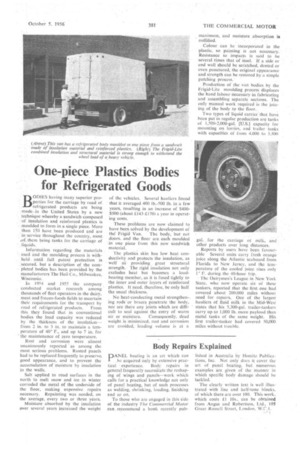One-piece Plastics Bodies for Refrigerated Goods
Page 71

If you've noticed an error in this article please click here to report it so we can fix it.
BODIES having many superior properties for the carriage by road of refrigerated products are being made.in the United States by a new technique whereby a sandwich composed of insulation and reinforced plastics is moulded to form in a single piece. More than 150 have been produced and are in service throughout the country, most ,of them being tanks for the carriage of liquids.
Information regarding the materials used and the moulding process is withheld ..until full patent protection is secured, but a description of the completed bodies has been provided by the manufacturers The Heil Co., Milwaukee, Wisconsin.
In 1954 and 1955 the company conducted market research among thousands of fleet operators in the dairy, meat and frozen-foods fields to ascertain their requirements for the transport by road of refrigerated products. From this they found that in conventional bodies the load capacity was reduced by the thickness of the insulation-from 2 in. to 3 in. to maintain a temperature of 40° F., and up to 7 in. for • the maintenance of zero temperature. Rust and corrosion were almost unanimously reported as among the most serious problems. Rusted panels had to be replaced frequently to preserve, good appearance, and to prevent the accumulation of moisture by insulation in the walls.
Salt applied to road surfaces in the north to melt snow and ice in winter corroded the metal of the underside of the floor, making expensive repairs necessary. Repainting was needed, on the average, every two or three years.
Moisture absorbed by the insulation over several years increased the weight of the vehicles. Several hauliers found that it averaged 400 lb.-500 lb. in a few years, resulting in an increase of S400S500 (about f1434170) a year in operating costs.
These prOblems are now claimed to have been solved by the development of the Frigid Van. The body, but not doors. and the floor are each moulded in one piece from this new sandwich material.
The plastics skin has low heat conductivity and protects the insulation, as well ai providing great structural strength. The rigid insulation not only excludes heat hut becomes a loadbearing member, as it is fused tightly to the inner and outer layers of reinforced plastics. It need, therefore, be only half the usual thickness.
No heat-conducting metal strengthening rods or braces penetrate the body, nor are there any joints which are difficult to seal against the entry of warm air or moisture. Consequently, dead weight is minimized, rust and corrosion are avoided, loading volume is at a maximum, and moisture absorption is nullified.
• Colour can be incorporated in the plastic, so painting is not necessary. Resistance to impacts is said to be several times that Of Steel. If a side or end wall should be scratched, dented or even punctured, the original appearance and strength can he restored by a simple patching process.
Production of the van bodies by the Frigid-Lite moulding process displaces the hand labour necessary in fabricating and assembling separate sections. The only manual work required is the joining of the body to the floor.
Two types of liquid carrier that have been put in regular production are tanks of 1,500-2,000-gal. [U.S.] capacity for mounting on lorries, and trailer tanks with capacities of from 4,000 to 5.300 gal. , for the carriage of milk, and other products over long distances.
Reports by users have been favourable Several units carry fresh orange juice along the Atlantic seaboard from Florida to New Jersey, and the temperature of the cooled juice rises only 1° F. during the 40-hour trip.
The Dairymen's League in New York State, who now operate six of these tankers, reported that the first. one hadcovered about 200,000 miles without need for repairs. One of the largest hauliers of fluid milk in the Mid-West states that his 5,300-gal. trailer-tankers carry tip to 1,000 lb. more payload than metal tanks of the same weight. His first trailer-tanker had covered sopa miles without trouble.
















































































































